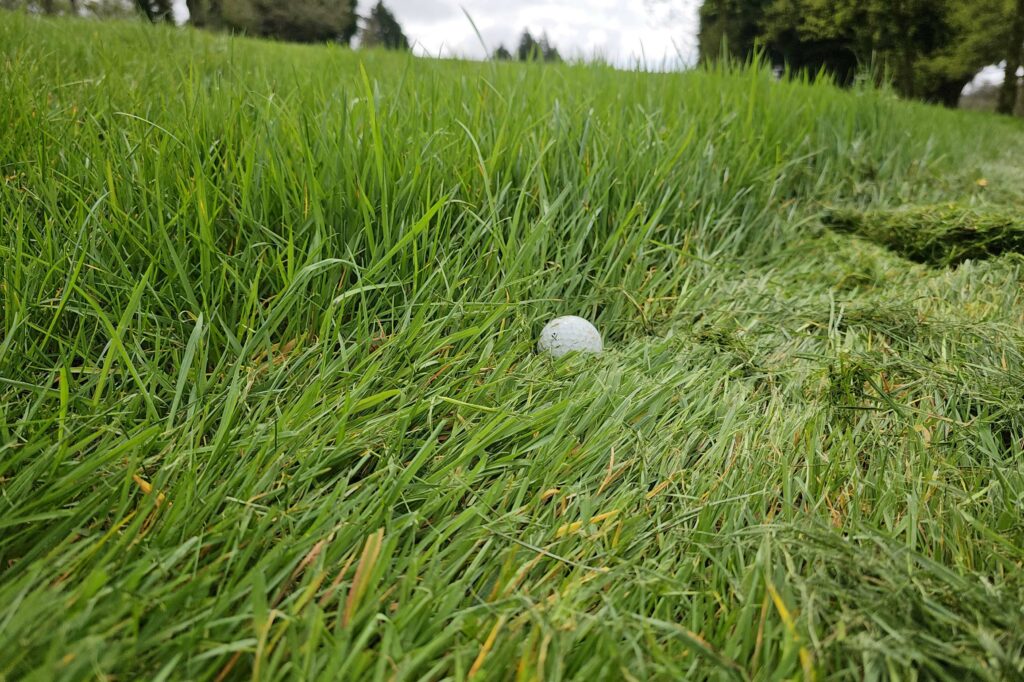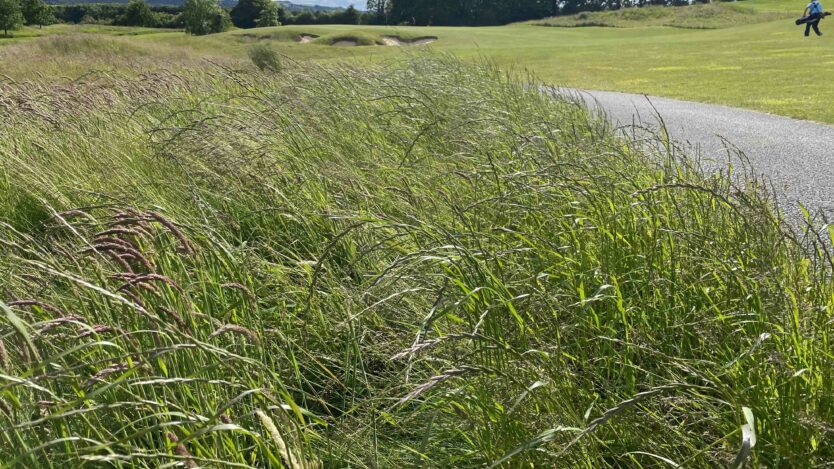Wet and warm weather – it’s perfect for grass growing. And our greenkeeping teams have been right up against it over the past few weeks in one particular part of the course
You mow it on Monday and it’s back by Friday! What do you get when you mix wet weather with warm temperatures?
An explosion of grass. If you’ve checked out any road verges over the last few weeks, you’ll have noticed that once carefully manicured kerb suddenly went waist high.
It’s no different on a golf course. Our grass plants love warm soil temperatures, revelling in the moist, humid, conditions and they start reaching for the sky like they’ve sprouted wings.
A golf course is not a road kerb. It’s a massive site measuring, in some cases, hundreds of acres.
We want tees, fairways, and greens to look as good as possible and greenkeeping teams must prioritise those areas.
But we’re also not very good at keeping our balls on the short stuff and that means we can often find ourselves in rough during a growth spurt.
So what sort of challenges does managing the rough provide when growing conditions are at their most favourable? How much time do greenkeepers spend cutting it back, how does that time impact the rest of the course, and should we be more tolerant when our ball is buried off the beaten track?
We asked two course managers to give us the lowdown about how they manage the thick stuff and the effect it has on their day-to-day job.

“By Friday, you wouldn’t have known it had been cut”
Antony Kirwan is course manager at Romford, in Essex
“It takes us 33-man hours to cut our rough – wall to wall,” Kirwan says. “That’s realistically five days, given that guy doesn’t sit on that machine from Monday to Friday.
“He’ll help rake bunkers. He may do set-up. Rough is down the pecking order a little bit. You start at your green and you work your way out. I mean, you’re not going to miss a greens mow so you can get some rough cut.”
You won’t believe how quickly it grows back at Romford.
Kirwan adds: “What [rough] you cut on a Monday, by Friday you wouldn’t have known it had been cut – especially during May.
“This has been the best growing spring I’ve known for quite some years. Obviously, we’ve had a lot of rainfall. February was above average temperatures. March was the same.
“There was no frost in April. That’s the first time that’s happened since I’ve been keeping data. I’ve been in the game 34 years and I really could count on my hand how many times I’ve been through April without frost.”
Sometimes, whether it’s staff numbers, holidays, or circumstances – perhaps a competition is being held – there are also other priorities a course manager must consider first.
“[At this time of year] everything needs to be cut – not just the rough – and there’s no way I’m not going to cut the fairways or they would be poor. We were cutting them three times a week during May and we’re still cutting twice and three times a week now.
“We don’t cut the rough that high, either. We cut at two- and three-quarter inches but it can be quite dense in areas and the ball can disappear.”
Kirwan estimates rough probably makes up about 40 per cent of their 96-acre site at Romford. The choice for his team of seven can come down to manpower. Have they got enough people to make sure the main playing areas are presented as members would expect?
“Everyone plays off the tee. Everyone putts on the green. If you start missing those areas out, members will soon pick up on that and be more critical than the odd bit of rough where one person has gone in a square metre that, unfortunately, has not been cut,” he says.
“But it’s just growing so quickly and they are low traffic areas. If you get a high wear traffic area – people predominantly walk up the fairway and off the tee – they will stay short.
“But rough is a low traffic, high maintenance area where, if you haven’t got the manpower and if you haven’t got the right machine for the job, it can be extremely difficult.”

“We talk here about the grass growing behind you”
Lucy Sellick is course manager at Wenvoe Castle, near Cardiff
It’s torrential rain followed by 20 degrees. They had 1.6 metres of rain at Wenvoe Castle last year and the first quarter of 2024 followed up with 650mm.
For Lucy Sellick, the combination means “humidity goes off the charts”. And, yes, that means a lot more rough.
“Growth potential is probably at its maximum,” she explains. “There are warmer temperatures, soil temperatures have increased, it’s moist and it just means it grows and grows and grows.
“We talk here about the grass growing behind you. That’s where we are at the moment. Every machine is flat out and just when you think you’ve got it down, you’ve got to go back around and start again.”
Sellick has a team of four at Wenvoe Castle but was running with three over a chunk of spring. With one rough mower in use, dealing with what the weather brings is a significant drain on time.
“It will be one of the team on the [rough] mower probably for three days straight. He’s on it Wednesday, Thursday and Friday.

“When you’re cutting on a Wednesday, you’re cutting up 50mm. But then that bit doesn’t get cut again until the following Wednesday and it’s closer to 75mm or 100mm. It can be double the height of grass in that time.
“That’s pretty much every week – even to the point where we’ll see some areas that are thicker than others and so I might even send them over on a Monday, just to try and get those landing zones and stop the complaints of members losing golf balls.”
Strimming, bunker weeding, and other small projects are dropped as attention centres squarely on cutting and making sure playing surfaces are up to scratch.
“A lot of members or golfers might not realise greens are cut daily,” Sellick explains. “That’s a three-hour task. We like to do tees three times a week. They are three-hour tasks. We cut aprons two or three times a week.
“Fairways are twice a week – and then picking up any of the long ones a third time – so they take a day-and a bit to cut. You’re talking three days just cutting fairways.”
Add in the rough too and it takes full focus. But delving into the deep stuff is not only time consuming.
“It’s thick and lush and soft and it almost grabs the ball,” Sellick explains. “And on top of the long grass, you’ve also get the debris. So you might have cut it today, but that would have left a lot of grass clippings around because rough mowers don’t collect them.
“So you might be looking for your golf ball in the grass and you might be looking for it under a lump of debris.
“We’re lucky. We’ve got a tractor mounted blower so I can send someone out behind the rough mower and just distribute those grass clippings. But then you need the manpower to do that as well.
“So that’s the kind of extreme measures we’re taking at the moment.”



